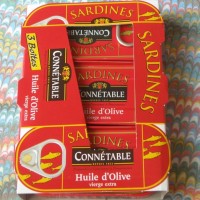It all started so innocently. I was going to write a blog about a simple and unremarkable café meal, the sort of thing that warms one up on a cold December day with a glass of vin chaud, and before I knew it, I had stumbled into a culinary and historical minefield.
First, the culinary difficulties. I wanted a straightforward recipe for a Paris dish so unremarkable that it is a cliché: the croque monsieur. I consulted some of my French cookbooks; I searched the Internet. And within a few minutes, I was knee-deep in controversy. What is a croque monsieur?
I would have said that it consists of a couple of slices of even-textured bread (not a baguette), some ham in the middle, grilled with a bit of butter, and topped with a cheesy béchamel sauce, which might include a dash of mustard.
Nearly every element in that combination appears to be contested. Let’s start with the bread. Ginette Mathiot, author of the classic French cookbook Je Sais Cuisiner, calls for pain de mie (white sandwich bread), preferably a bit stale (rassis), with the crusts cut off. But others recommend fresh pain de mie, sturdier pain de campagne, or pain complet (wholewheat/wholemeal bread). What you do with the crusts is your business.
Can we all agree on the ham? Up to a point. Ginette Mathiot allows for a “croque monsieur économique” without any ham at all. Clothide Dusoulier, in her book Chocolate and Zucchini, specifies “brine-cured ham” rather than dry-cured ham. Fine, whatever.
Cheese? Julia Child, for some reason, favoured Mozzarella. Most recipes specify Gruyère. Some mention Emmenthal. But those are Swiss cheeses, and there are some nationalists in the room. Clothilde, who is French, allows for Comté as an alternative, and Nigel Slater (author of Real Fast Food), being English, says Cheddar is an option. Fair enough. I’m Canadian: can I make it with Oka?
And what do you do with the cheese? Grate it or slice it? Put it in between the bread slices with the ham or on top? Add it to a béchamel sauce? Take your choice. You will find at least one celebrity chef who endorses your preference.
Finally, grill it, bake it, or heat it in a pan with lots of butter? Or – as Samuel Chamberlain suggests in his book Clémentine in the Kitchen – drench it with egg and make it into a sort of pain perdu (French toast) version? I had something like that in a Canadian diner once. It was vile. Then I found this comment on a recipe website:
Some people will tell you that a croque-monsieur is dipped in an egg wash – like French toast – before being fried. Remove those people from your autodialer this instant. These same people may also tell you that you can purchase a special croque-monsieur grilling iron, with shell-shaped indentations on each side that fold together, squeezing the sandwich inside, which is then placed on a grill and turned when half done, which produces a shell-shaped sandwich. While this is technically true, it has nothing to do with the traditional croque-monsieur, and since you’ve already deleted these people from your autodialer, you needn’t be troubled by them further.
I have no idea who wrote that, but I couldn’t agree more.
As for the historical difficulties, the rumours start with the Larousse Gastronomique, which states that the first croque monsieur (in all history?) “was served in 1910 in a Parisian café on the boulevard des Capucines.” Nine out of ten recipe writers repeat that incomplete and implausible factoid. I ask you, if the date is known and the street is known, then why not the restaurant or the chef?
Let’s start with the date. Apparently Proust had a childhood fondness for croque-monsieur, and he was born in 1871. He mentions croque-monsieur in a letter he wrote to his mother in the 1890s. So 1910 sounds a bit off the mark for the very first one.
Then the place. When I Googled “croque monsieur” and “boulevard de Capucines,” I found a reference to a restaurant called “Le Trou dans le Mur” (the Hole in the Wall). Here is the story according to “Paris le Nez dans l’Air” (my translation):
It is often said that the French, and the Parisians in particular, are adept at “System D.” D for “débrouiller” [meaning coping with whatever life dishes out]. Sometimes this ability reaches the heights of ingenuity. On February 23, 1848, in the early days of the revolution that would usher in the Second Republic, a cannonball smashed into a concierge’s lodge at 23 boulevard des Capucines. But the cannon blast was not wasted. The concierge, who miraculously survived, had the bright idea of exploiting the yawning gap that exposed his lodging to the sidewalk. Thus was born the café known as “The Hole in the Wall.” It evolved from a local watering hole to a chic bar frequented by the who’s who of Paris. It is even said that in this location was born an English specialty: the croque monsieur.
It’s a great story. And I don’t believe a word of it. According to histories of 1848, there was a bloody stand-off on the boulevard des Capucines on the day in question, but it started when a group of rioters confronted a group of soldiers and a gun went off. The violence escalated and when it was over, between 30 and 50 people were dead. But in the accounts I have read, there were no cannons involved. This was not a pitched battle, planned in advance with heavy artillery in place. There were disorganized rioters and frightened soldiers with guns who overreacted. And I found no mention of any holes in walls. At least not on the day in question. Perhaps it was created some other time, during some other conflict. Or by some other means.
Then I tried Googling “Trou dans le Mur/Hole in the Wall.” The search took me to Ernest Hemingway, who wrote:
The old Hole in the Wall bar…was a hangout for deserters and for dope peddlers during and after the first war. The Hole in the Wall was a narrow bar, almost a passageway, on the rue des Italiens with a red-painted façade, which had, at one time, a rear exit into the sewers of Paris from which you were supposed to be able to reach the catacombs.
Oh, sure. Hemingway makes it a dodgy bar, puts it on the next boulevard over (talk about a moveable feast), and adds an irrelevant and implausible detail about the catacombs (which are on the other side of the river). He doesn’t mention what he ate there. It’s just another Hemingway hangout with an improbably colourful clientele.
Finally, thanks to Gallica, I found a reference in a 1927 guidebook called Guide des plaisirs à Paris. It contains the following note: “American Bar (Au trou dans le mur), 23, boul. des Capucines – owes its name to the minuscule entryway on to the boulevard.” No mention of the specialité de la maison. There was also a Café Americain at 4, boulevard des Capucines, pictured in this photograph from Gallica. It is now the Grand Café Capucines.
Either or neither might have been the place where socialites first ate croque monsieur.
So what is one to make of all this?
I think I will put my faith in Proust. I believe that croque-monsieur was a 19th-century dish that had a funny name because it was intended for little kids (rather like Toad in the Hole for English children). And at some point before the First World War, some chef somewhere, likely in the touristy zone around the Opera that includes the boulevard des Capucines, thought it would be fun to make this nursery food into a chic supper for his clients after a night on the town. And the rest, as they say, is history. Sort of.
Text by Philippa Campsie

























What? Not a word about Croque Madame? You chauvinist pig!
Actually, I’ve never cared for the version with the egg. But thank you for the reminder about the alternative version.
The best bit of fun reading in a long time Philippa! Thanks a lot!
Ah, a story after my own heart… Isn’t it fun to see how a story sometimes “grabs you by the hand,” and takes you places you had never imagined writing about? Le Croque-Monsieur is a favorite café/bistro lunch of mine, so I particularly enjoyed this wonderful story. If that is all right with you, I will re-post it on my blog’s Facebook page later on today… Merci beaucoup. Veronique (French Girl in Seattle) PS: For the anecdote, my mother and grandmother have always used “pain de mie,” jambon cuit, and gruyère, as well as a manual grilling iron (that went on the stove,) to make their croque-monsieur. Not sure all “experts” would agree, but these tasted pretty good to me! 🙂
Absolutely delightful reading – great idea not to take the history of the croque too seriously. I’m with your conclusion on its origin.
Thank you for the very interesting background on this delicious sandwich. I can devote more of my time trying all the varieties available in the cafes I happen to visit. If its served as a croque- monsieur and it tastes good, I am happy!
You are a splendid treasure, I so enjoy your archaeological bent, digging up the facts, when possible, about matters important to nuts like me…and you, I suppose…that give great pleasure and stimulate wonder.
Chapeau!
Thanks – I often stop by your blog to see if a new story is up, and I appreciate the time you invest. So… might one interpret croque-monsier as “Mr. crunch?”
I suppose you could say that, but it sounds much better in French!
Excellent – this could be the beginning of a very interesting book on the stories – and lies and arguments – behind famous French recipes!
Sounds a bit like the arguments over Welsh Rarebit/Rabbit, which lacks the ham, but does have the cheese and bread. No-one can ever agree if it’s rarebit or rabbit, and everyone has a different recipe, discussing the ‘right’ bread, the ‘right’ cheese, whether you should add mustard, whether it should be a kind of bechamel sauce, whether it should include beer and if so what type… who would have thought cheese on toast or toasted sandwiches could be so complicated!
from Wikipedia:
Emmental de Savoie, from Savoie, France, has PGI status
Emmental français est-central from Franche-Comté, France, also has PGI status
In 2001, Gruyère gained the Appellation d’origine contrôlée status. Since then the production and the maturation is defined in the Swiss law, all Swiss Gruyère producers must follow these rules. To be accepted throughout Europe as an AOC, the “Interprofession du Gruyère” in Switzerland plans to make a transnational AOC with the French producers of Gruyère.
so they could be considered french as well since they are made in France as well as Switzerland
The older I get the more I find I’m in touch with my inner anarchist.ha! Question everything — especially authority:) And that is what you have done with all these ‘historical’ accounts of the croque-monsieur. These vignettes illustrate why I shun tour guide presentations. It has long been my suspicion that much of what passes for facts on such tours is, in actuality, simply ‘a good story.’ Shame on Mr. Hemmingway! Bravo, Philippa!
Pingback: culture: the word on cheese